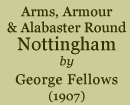< Colwick | Contents | Hoveringham >
St. Edmund's, Holme Pierrepont
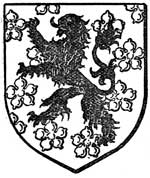 |
ARMS OF PIERREPONT—Argent, semee of cinquefoils gules, a lion rampant sable. |
AMONG many monuments to the Pierreponts in this Church are two of alabaster, both of which are to be found against the south wall. It may be mentioned here that near them is an unarmoured effigy in stone; there is no name attaching to it, so it would be unsafe to assert that the figure represents one of the family of Pierrepont; there is, however, a very similar figure of the same material in Mansfield Church, with which the family were identified in past years. There is also on the floor, between the two altar tombs at Holme Pierrepont, the alabaster trunk of a Knight wearing the camail, a jupon with scalloped edge, and horizontal swordbelt, but nameless; the effigy seems to have been sacrificed in order to make room for its more imposing neighbours.
The Pierreponts, as the name indicates, are of French origin, and take the name from "the Castle of Pierrepont on the confines of Picardy" (Deering p. 233). One of the name held a high command in the Conqueror's army, and was liberally rewarded for his services. The first of the family, however, to become identified with Nottinghamshire was Sir Henry Pierrepont, who (temp. Ed. I.) married Annora, daughter of Michael, and sister and heir of Lionel de Maunvers, of Holme, thereafter styled Holme Pierrepont. A line of illustrious men followed, the first of whom to be raised to the Peerage was Robert, who was created Baron Pierrepont and Viscount Newark by Charles I. in 1627 and subsequently advanced to the rank of Earl of Kingston-upon-Hull (1628). He was Lieut.-General of the King's forces in the East of England, and was instrumental in bringing 4,000 men to the Royal Army. He was known as the "good Earl of Kingston," and was accidentally killed in the Royal cause when being rescued from the enemy (see Burke's Dormant and Extinct Peerages) July, 1643. His son was made Marquis of Dorchester (1644), but the Marquisate died with him, whilst the Earldom of Kingston passed to his grand nephew, Robert Pierrepont.
In 1706, however, the title of Marquis of Dorchester was revived in the fifth Earl, and the holder was subsequently (1715) promoted to the dignity of Duke of Kingston-upon-Hull, and made a K.G. for his illustrious services to the State in the time of George I. The Dukedom became extinct on the death of the second Duke, when the estates passed to Mr. Charles Medows, who in 1788 assumed the name of Pierrepont, when the arms were probably changed from semee of cinquefoils to semee of mullets, as now used. He was created Baron Pierrepont and Viscount Newark in 1796, and Earl Manvers 1806.
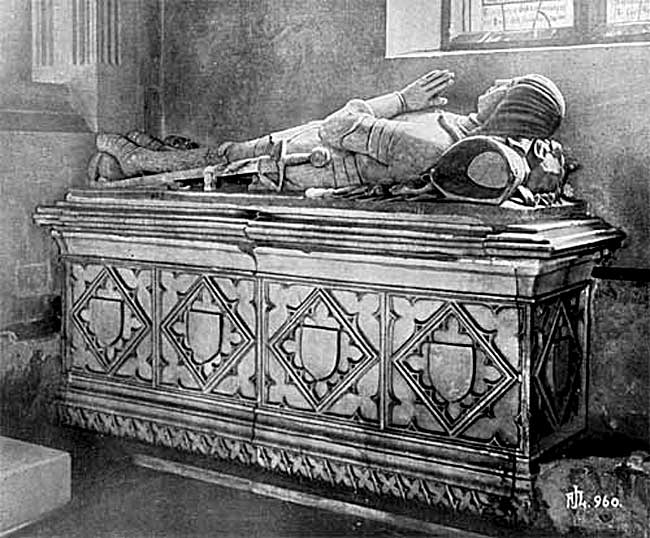 |
Tomb of Sir Henry Pierrepont (1441). |
The alabaster altar tomb under a window in the south aisle has no inscription on the chamfer, but there is little doubt it is that of Sir Henry Pierrepont, who fought in the Wars of the Roses, and who left instructions in his will, proved at York 18 December, 1499, that he should "be buried in the Church among his worshipful ancestors, and a tomb of alabaster to be made and sett upon his sepulchre, and graven by the discretion of his executors." A handsome tomb testifies to this day that his injunctions were faithfully carried out. The face is finely featured, with no moustache or beard but long hair, and upon the effigy the light from the adjoining window falls with good effect: he is clad in a suit of plate armour, wearing a Yorkist chain of suns and roses round his shoulders, from which a cross is suspended, a standard of mail at the throat, epaulieres, pass guards, and a short-hiked sword with straight quillons. The mantled helmet under his head carries the original family crest of a fox passant; his costume points to his having lived about the period when the disastrous battles between the rival houses of York and Lancaster were devastating England. These details, combined with the instructions he gave to his executors, seem to set at rest any ambiguity as to the identity of the person represented on this tomb, in spite of the absence of any inscription. The pattern of the carving of the panels of this tomb is very similar to others in the neighbourhood, such as that at Strelley, to John Strelley, armiger, who died 1488, and Radulphus Sacheverell, at Radcliffe-on-Soar (1539). It may be fairly inferred, therefore, that these tombs were executed by the same (probably local) "alabasterman."
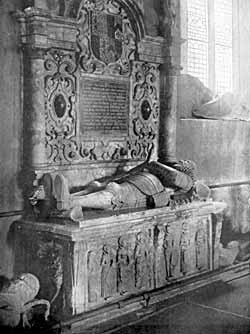 |
Tomb of Sir Henry Pierrepont (1615) at Holme Pierrepont. |
Close by is a sumptuous tomb of the same material to Sir Henry Pierrepont, Knight, who married Frances Cavendish, daughter of "Bess of Hardwick." Above the inscription, from which we learn that he died on 19 March, 1615, aged 691/2 years, is a shield with his arms, quartering those of Maunvers, argent, six annulets sable, two two and two AND HERIZ (an old Notts, family), viz., azure, three hedgehogs or, impaling Cavendish, sable, three bucks heads caboshed argent, with two quarterings. Above all is a Pierrepont shield of sixteen quarterings surmounted by a helmet and crest: whilst on the end of the tomb is yet another shield bearing Pierrepont impaling Cavendish. He is shown as wearing a moustache, pointed beard, and cropped hair, in a suit of heavy elaborately-chased plate-armour, with a ruff round his neck, sabbatons, his head upon his crested helmet, and his heels upon his gauntlets. On the panels are his children in miniature presentment, viz., a son in armour (this would be the Robert, first Earl of Kingston, already referred to), five daughters and an infant; each married daughter holds a shield in front of her showing the family arms impaling those of their respective husbands except in the case of Kelly. They married a Manners (there is a plaster cast of her face at Haddon Hall), Stapleton, Kelly, and Cartwright: all these smaller figures have suffered from damp.
Much of the big house at Holme Pierrepont has been pulled down. The family now chiefly lives at Thoresby, within the charming surroundings of the Birklands, in Sherwood Forest. It seems to be a tradition with the successive heads of the house that they should take an active part in the affairs of their country and county.
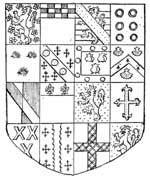 |
< Colwick | Contents | Hoveringham >
